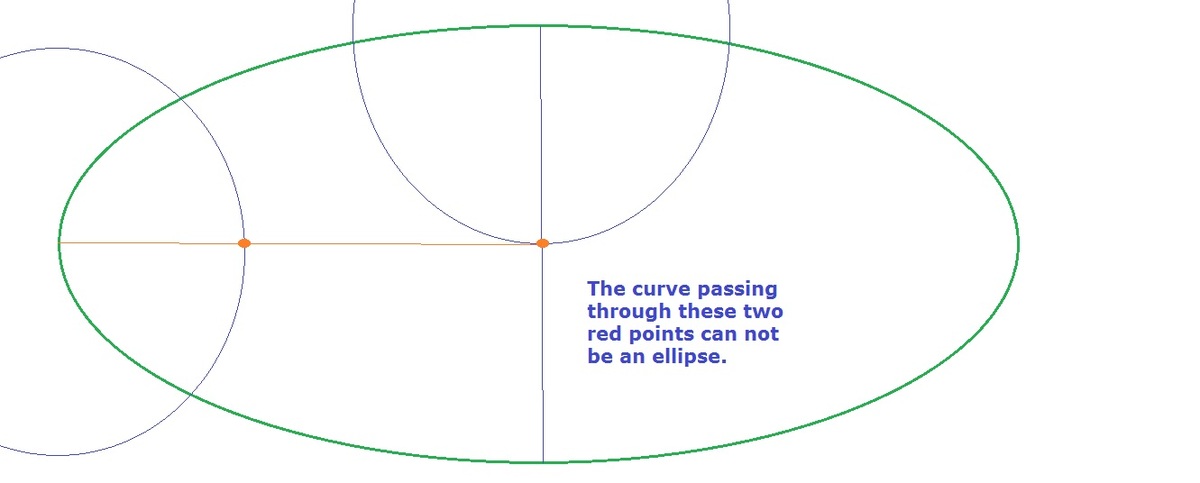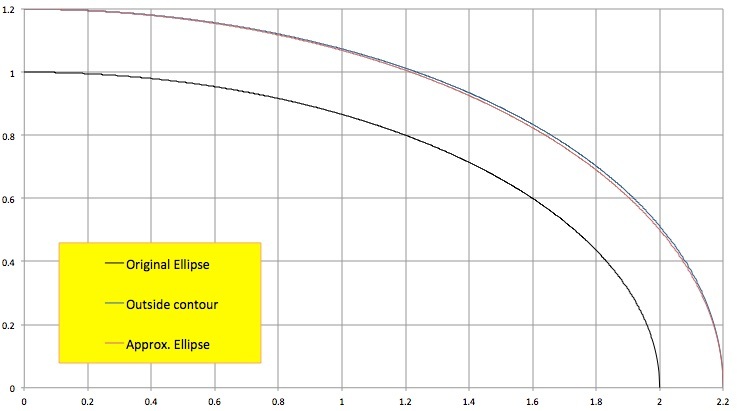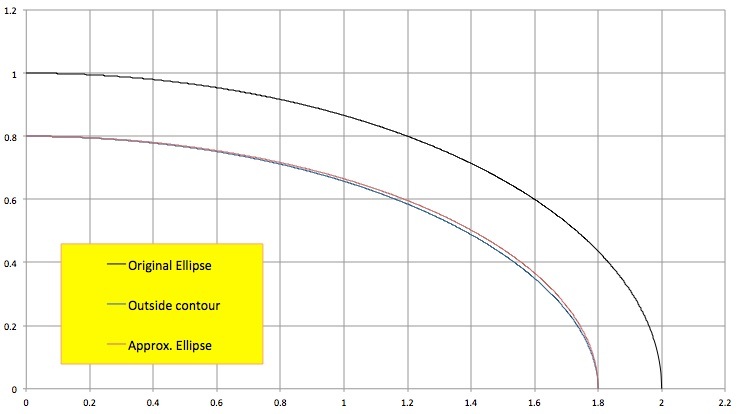Tracing an Ellipse
You trace a circle (the red one) using a pen with a thick circular end. Both the outside and inside borders of the trace are also circles (in blue):
If you trace any ellipse using the same kind of pen, will the outside and inside borders also be ellipses?
This section requires Javascript.
You are seeing this because something didn't load right. We suggest you, (a) try
refreshing the page, (b) enabling javascript if it is disabled on your browser and,
finally, (c)
loading the
non-javascript version of this page
. We're sorry about the hassle.
7 solutions
When faced with the original problem I thought that there must be an extreme situation that showed that the outside curve is not an ellipse but I just couldn't find it. You did that. I love this answer - very simply makes it visually very obvious that this is not an ellipse. Nice!
The challenge is to prove that "a very sausage-line shape" is not an ellipse...
Log in to reply
Since it contains a long section of straight line, and no ellipse does that, this is no problem.
Log in to reply
But you admit that "a line segment is not an ellipse either"-- so the straight edge is not perfectly straight. That complicates matters.
Log in to reply
@Arjen Vreugdenhil – It does. But we can see that the curvature of the sausage-like shape is nearly zero for much of the way, and nearly constant the rest of the time, which is not a property of an ellipse.
The reason I included this less than rigorous solution was to demonstrate very visibly that ellipse is not the answer. A rigorous solution was already provided.
A degenerate ellipse cannot look like the above. An ellipse can be constructed by tying a piece of string to the two foci and using a pencil to stretch the string, then following the locus of the pencil tip around the two foci. No such piece of string could possibly construct the above.
Log in to reply
If the length of the string is exactly the distance between to foci, then you get a degenerate case of a line segment, that is the minor axis equal zero.
Log in to reply
yes but not the outer sausage
Log in to reply
@Adrian Ferramosca – The outer sausage is a result of retracing the segment with a fat pen.
@Adrian Ferramosca – And that's the argument. The inner segment is a degenerate ellipse but the sausage is not any kind of ellipse.
The opposite case is a solution, where r1 and r2 are equal; in other words, a circle, which falls under the definition of ANY ellipse. The correct answer is yes.
Log in to reply
For a case to work for any ellipse, it has to work for all. The fact that it works for one case does not prove the proposition. However, if it does NOT work for just one case, it proves the proposition incorrect.

Well we can take extreme example. The radius of the pen circle is =length of minor axes. Then the point on inner curve when the pen center is at end of minor axis, is at the center, that is one end of major axes.
When the pen center is at end of major axis, again the point on the inner curve is on the major axis.
Thus the inner curve pass through the two points of the Major axes while the pen traces a quater
ellipse. Not what happens to an ellipse.
I can draw an infinite number of ellipses through these two points, so the two points by themselves do not show the inner curve is not an ellipse. If you extend your thinking to follow the pen all the way around the ellipse, you can show that the inner curve cannot be an ellipse.
Log in to reply
I have mentioned that this is only a quarter , and in a quarter , no ellipse intersects an axis twice.
Does that mean that when one issues a command in Autocad to offset an ellipse the offset ellipse is not an ellipse any more? AutoDesk people better inform us about that.
I thought about that also.
The following graph shows a quarter ellipse with semi-major axis 2 and semi-minor axis 1. The blue curve is the outside border of a trace with a circular nib of radius 0.2. The red curve is the orthogonal ellipse matching the blue curve in the points ( 2 . 2 , 0 ) and ( 0 , 1 . 2 ) . The red and blue curve do not coincide, showing that the blue curve is not an ellipse.

And here is the same graph for the inside border:

The graphs were generated as follows. First, an orthogonal ellipse is defined by an equation a 2 x 2 + b 2 y 2 = 1 ; I chose a = 2 and b = 1 . Now determine the direction perpendicular to the ellipse at a point ( x , y ) : n ∝ ( a 2 x , b 2 y ) . The length of this vector is x 2 / a 4 + y 2 / b 4 , but we want a vector of length r (the nib radius). Thus we scale n . Finally, add it to the original position ( x , y ) to find the point on the boundary: ( x ′ , y ′ ) = ( x + x 2 / a 4 + y 2 / b 4 r x / a 2 , y + x 2 / a 4 + y 2 / b 4 r y / b 2 ) .
It might be more elegant to prove that the curve defined by ( x ′ , y ′ ) does not obey the equation of an ellipse; but the algebra is rather nasty!
Apparently it seems that the trace of inner and outer bounds are similar yet analytically there are errors in tracing due to constants added in each part of the ellipse's trace(according to Integration). But geometrically, the traces are tangents at every point of definition of the curve. Hence,there is only an approximate tracing of the curve in all practical perspectives as the ellipse is considered to be an exact ellipse. Therefore the answer is No. Is this approach correct?
The general form of an ellipse is a 2 x 2 + b 2 y 2 = 1 .
If we consider the inner border one, it must have smaller axes. Let's mark the difference with Δ , which results in the following equation: ( a − Δ 1 ) 2 x 2 + ( b − Δ 2 ) 2 y 2 = 1
From there, it is easy to see that there is always some Δ 1 and Δ 2 for which the equation becomes undefined and unsolvable. This means that the equation is not a good description for all inner borders and therefore the inner border for any ellipse is not an ellipse.
Your reasoning seems to show that the inside boundary is not always an ellipse. But what about the outside boundary? What about ellipses big enough so that a > Δ 1 , b > Δ 2 ?
Being "not a good description for all" is not the same as being "not a good description for any"...
Log in to reply
The way the "any" is worded in the question (I read it as "arbitrary") and the binary answer choice, a single counter-example is enough.
"The inner border of any ellipse is not an ellipse". How about a circle?
Take an ellipse with minor semi-axis length equal to the radius of the circle. Then the inner blue path will cross itself at the center of the ellipse. This path cannot be an ellipse.
If we have two ellipses one with a value of A to be a and the other (a+1), and B to be b and (b+1) as we assume the pen has a radius of 1, now if we expand the equation of an ellipse and differentiate, we see that the gradient function of the two ellipses are different so they will not be borders to each other as they must have the same gradient function, in a circle to change the radius you have to add a constant to the end of the equation i.e. like ( x + 3 ) 2 + ( y − 3 ) 2 = r 2 all we have to do is add to the r 2 side, and as d x d ( r 2 ) = d x d ( r 2 + k ) where k is a constant, however in the case of an ellipse b 2 x 2 + a 2 y 2 = a 2 b 2 which becomes b 2 x 2 + 2 b x 2 + x 2 + a 2 y 2 + 2 a y 2 + y 2 = a 2 b 2 when a = a + 1 and b = b + 1 , it can easily be seen that the derivatives of these two equations are not equal.
Since an eclipse is different than a circle, the lines would cross each other, letting there be no eclipses forming, correct me if I'm wrong.
Correct me if i'm wrong, but isn't circle also ellipse? So the outside and inside borders are both circles and ellipses.
One could argue that a line segment is not an ellipse either, but there is one very close to it, with a tiny short axis, and tracing it will result in a very sausage-line shape, that is a shape with curvature practically zero for a large distance, much larger and close to constant for a time, then again close to zero, and again almost constant. Not a behavior of an ellipse.